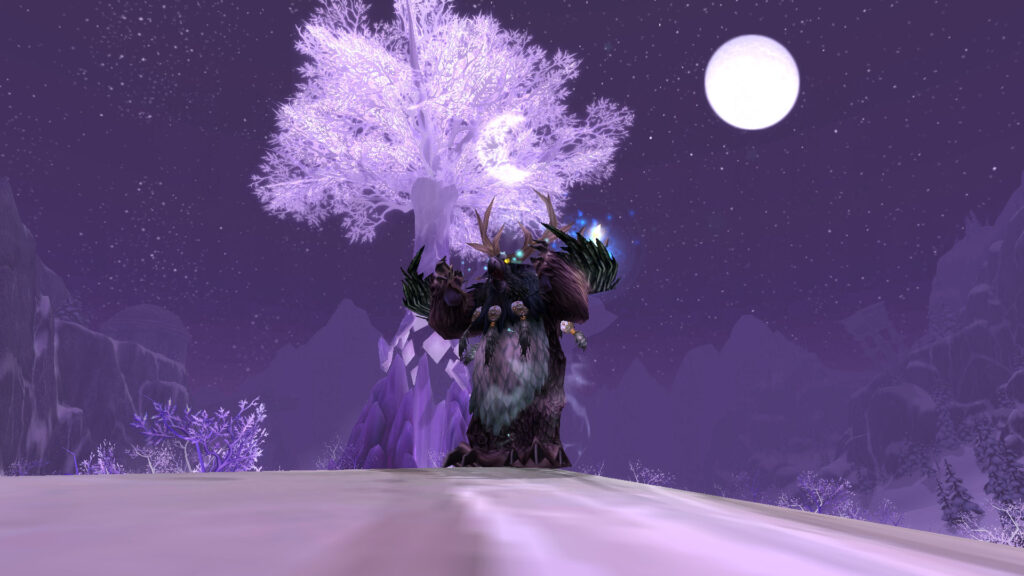- Author: Nevermore
- Date: February 16, 2022
- Updated: February 16, 2022
- Expansion: WotLK Classic
In this section we will be covering PvP rotation in Wrath of the Lich King and discussing your abilities/spells in further detail.
With how Player-versus-Player combat works in World of Warcraft Wrath of The Lich King, we can only discuss a single-target rotation, since in most cases you will want to focus on a single enemy to demonstrate your prowess.
Player-versus-Player requires a bit of a different mindset compared to PvE content; PvP requires fast thinking, fast reactions, and adaptability. Unlike the PvE scenarios, the encounters here are not scripted – you can expect anything from your enemy. However, this does not mean their actions can’t be predictable, depending on their situation at the moment (and yours).
Druids are known for their immense versatility, offering the role of a hybrid class. They bring massive amounts of damage, crowd control, debuffs, and healing to the table. The Balance Druid, in particular, is a master of burst damage, while also having some methods of crowd control against the enemies. On top of it all, this build can also provide some sustainability both to itself and its allies.
The biggest advantage offered by a Balance Druid is the ability to “delete” an enemy in mere seconds – prowling in the shadows as a feral beast before aggressively striking their enemy.
In this guide, we will cover the abilities of a Balance Druid, strategies for initiating and controlling the fight, and how to best take advantage of the “Line-of-Sight” mechanic.
Shapeshifting
First of all, we will talk about the trademark of the Druid class. That is, their ability to shapeshift. Shapeshifting removes movement-impairing effects, but it also offers huge versatility to the Druid class overall. You will have access to several forms, each of them fulfilling unique roles and offering different bonuses.
The first form that you acquire, the Bear Form (which later turns into the Dire Bear Form), can be used in PvP scenarios to maximize your survivability. You can use it to mitigate an enemy’s burst or to offer time for your healing-over-time spells to take effect.
The second form that we will talk about is the Cat Form. If you are confused, thinking, “hey, this is not a feral guide,” let me assure you that the Cat Form is still useful to the Balance Druid in two distinct situations.
The first situation is the initiation, where you can make use of the Prowl spell to confuse your enemies and then attempt a surprise attack with the Pounce spell. The second situation where the Cat Form comes useful is to reset the encounter. You can use the cat form to attempt to break combat with Dash, then line-of-sight, then immediately Prowl.
The Travel Form allows increased movement speed, in a manner similar to the Ghost Wolf spell. It’s mainly used to break line-of-sight with the target and reset the fight – the reset is completed by either using healing-over-time spells or eating food.
However, the main form of the Balance Druid is the Moonkin Form, often called “Boomie” because of its signature high burst. This form empowers you with various effects: notable examples include increased armor value from your gear, increased critical strike chance rating, 2% mana regeneration from single target critical strikes, and damage reduction while stunned.
As you can see from that list, the Moonkin Form offers plenty of beneficial effects, while also giving you one of the best passive effects in the game… it turns you into a huge, huggable fluffball!
Offensive Abilities
As far as abilities go for the Balance Druid, we will first talk about your most powerful spell – Starfall. This is an area-of-effect spell that provides the Boomkin with an extremely powerful burst. Important to note – you should always use this ability on cooldown. The awesome thing about Starfall is that it acts as a buff, meaning you do not have to channel it.
Your main filler spell (definitely one you will find yourself casting most of the time) is Wrath. With enough haste this spell becomes very spam-able – some Balance Druids even manage to reduce its cooldown down to the Global Cooldown limit.
Another one of your bread-and-butter spells will be Starfire. Even if the cast time of the ability is quite high, you can still manage to use it at the beginning of the fight or if the distance allows you to do so. While it might seem like casting Starfire in this manner will not be worth it, remember that due to our Eclipse talent, Starfire is the best way to initiate a burst – to empower your Wrath spam.
Moonfire is a damage-over-time spell that you will want to upkeep on the target at all times, especially if you have the Glyph of Moonfire. However, you should not mindlessly spam it; applying it to the target will be more than enough here.
Insect Swarm, just like Moonfire, is another dot that should be on the target at all times. In addition to providing damage, it reduces the target’s chance to hit.
Lastly, for our offensive spell, we will mention the Force of Nature. This spell should be used immediately after engaging your target. The treants will last 30 seconds and their damage is something that should not be overlooked. Not all the builds have this talent chosen due to how the build functions, but you can consider it a nice offensive option in your arsenal.
Crowd Control
Now that we have gone over your main offensive spells, we will move to the control spells section. The Balance Druid has access to several crowd control spells, which open up the potential to lock down a target while bursting the other, or to lock down your main target to set up a perfect combo.
One of the specific spells available to the Balance Druid is Typhoon. It knocks back your target and leaves it with the daze effect for 6 seconds. This spell is on a rather short cooldown, just 20 seconds. This makes it a great option for distancing yourself from a melee attacker that tries to burst you down.
Entangling Roots is another control spell that can be used in synergy with Typhoon. This one roots the target down for 3.5 seconds, allowing you to cast Starfire, spam Wrath, or simply to gain distance and heal yourself.
You also have access to spells like Cyclone, which makes the target invulnerable for 6 seconds, but prevents it from performing any actions. You can effectively spam it on the target to cc-lock it. For example, this can be done in an arena to render one target useless while destroying his or her partner.
Another spell that falls into the crowd control category (but also counts under the defensive category) is Nature’s Grasp. You can activate it to proc Entangling Roots on any melee attacker. It is quite a useful spell for situations when you are trying to distance yourself or line-of-sight the target.
Lastly, we will talk about Barkskin. This spell is your main defensive tool whenever you feel that you are about to be burst down or are getting attacked by multiple enemies. This spell is usable in any of your shapes, even while being stunned, incapacitated, asleep, frozen, or feared.
In a case of an emergency, you can use Barkskin in combination with the Dire Bear Form to mitigate massive amounts of damage.
Combat Strategies
Now that we have gone over the main abilities of the Balance Druid, we will talk about how to properly initiate an encounter and effective fighting strategies.
There are several ways you can open up an encounter – it vastly depends on where you find yourself and how many enemies you plan on fighting. If it is in the open world and you are the first to be attacked, you can try to place healing-over-time spells on yourself and then Cyclone the target to reset the fight. Your goal after that should simply be maintaining crowd control on the target until you manage to dot them with Moonfire and Insect Swarm. After that, you should perform your usual spam of Starfire and Wrath.
If you find yourself in a battleground, you should either blend in with the caster line or try to attack a separated target. Attacking a separated target is usually done by first entering Cat Form, then staying in stealth by using Prowl to help yourself land a successful stun on the target with Pounce. Afterwards, you can open up with your dots and Starfall, followed up by an instant Entangling Roots to root the target in place and allow you to cast more abilities. In case the fight goes sideways, you can simply reset it with either Typhoon combined with a fast Regrowth and Rejuvenation, or just Cyclone the target and run away.
In arenas the situation can get more complex – your opener can become the difference between winning or losing. You can opt-in for several openers, but the important thing is to always start in Cat Form and be prowled. Afterward, you can either start by using Pounce on the target and just follow it up with a Cyclone, or you can wait for the opposing team to engage your partner and then place yourself at a safe distance to be able to spam your abilities.
You also have the choice to start mounted and simply run in, throwing one of the opposing members off the edge of the arena with Typhoon. Of course, the usefulness of this particular opener depends on the arena you find yourself in.
Line-Of-Sight
Finally, let’s conclude by discussing the line-of-sight. The term Line-of-Sight (LoS) applies to anything that simply breaks the sight of your opponent to prevent them from casting an ability. Of course, it will not be easy when it comes to a melee attacker, but it still works in the same way: you are simply not allowing the attacker the required distance to land a melee swing on you.
As a Druid, you are one of the classes that can benefit the most from this mechanic because of your shapeshifting. Shapeshifting allows you to break any movement-impairing effects, effectively removing any Slows from you. The LoS tactic can be achieved with two forms, the Cat Form and the Travel Form. The Travel Form will be your main way to LoS a target. The Cat Form is not usually as good for LoS, but you can use it in combination with Dash in order to accomplish a makeshift escape.
LoS-ing a target in arenas can be accomplished by running around pillars or climbing atop ramparts, then simply jumping down in order to run around another pillar. Think of it as a cat-and-mouse game, only you are the mouse trying to outrun your opponent – either to wait for your cooldowns, reset the fight, or to allow your heal-over-time spells to take effect.








